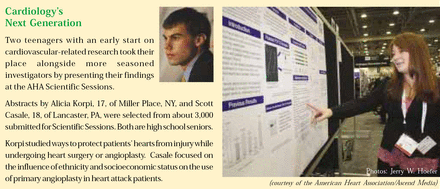Summary
FIELD (Fenofibrate Intervention and Event lowering in Diabetes), the largest type 2 diabetes intervention trial, looked at fenofibrate's effects on coronary mortality and morbidity. FIELD lead investigator professor Anthony Keech, MD, University of Sydney, Australia, stated “Atherogenic diabetic dyslipidemia may be particularly amenable to fibrate therapy.” He noted that fenofibrate reduces triglycerides (TG), total cholesterol (TC), and LDL cholesterol while increasing HDL cholesterol.
- clinical trials
- lipid
- clinical trials
- diabetes mellitus (Diabetes)
FIELD (Fenofibrate Intervention and Event lowering in Diabetes), the largest type 2 diabetes intervention trial, looked at fenofibrate's effects on coronary mortality and morbidity. FIELD lead investigator professor Anthony Keech, MD, University of Sydney, Australia, stated “Atherogenic diabetic dyslipidemia may be particularly amenable to fibrate therapy.” He noted that fenofibrate reduces triglycerides (TG), total cholesterol (TC), and LDL cholesterol while increasing HDL cholesterol.
FIELD included 9,795 subjects with type 2 diabetes from 63 centers in Australia, New Zealand and Finland, randomizing them to fenofibrate 200 mg daily or placebo and following them for 5–7 years. FIELD included subjects with or without pre-existing vascular disease with diabetes onset at age >35 years (age 50–75 years). Cholesterol level requirements were as follows: TC 3.0–6.5 mmol/L (116–251 mg/dL) plus either TC to HDL-C ration >=4.0, or TG > 1.0 mmol/L (>89 mg/dL). The primary endpoint was nonfatal myocardial infarction (MI) plus coronary heart disease (CHD) death.
Analysis of the primary endpoint showed an 11% nonsignificant risk reduction (P=0.16) for fenofibrate. Separating out the endpoint components revealed a significant reduction for fenofibrate (HR 0.76, P=0.01) in nonfatal MI, but a nonsignificant increase in CHD death (HR 1.19, P=0.2). In secondary endpoint analysis, there were significant advantages for fenofibrate in total cardiovascular disease events (12.5% versus 13.9%, P=0.035), and in need for both coronary revascularization (5.9% versus 7.4%, P=0.003) and all revascularization (7.8% versus 9.6%, P=0.001). Total deaths were similar between groups, but marginally higher in the fenofibrate group (7.3% versus 6.6% for placebo, p=0.18). Fenofibrate was well tolerated alone or in combination with other drugs.
Keech concluded that while the FIELD primary endpoint of nonfatal myocardial infarction (MI) plus coronary heart disease (CHD) death was not met, non-fatal MI was reduced by 24% in the fenofibrate group versus placebo. Commenting on the mixed results of FIELD, Keech pointed out that a higher rate of initiation of statin therapy in the placebo group (17% as compared with 8% for fenofibrate) may have skewed findings, masking risk reductions with fenofibrate by as much as 17–20%.
Cardiology's Next Generation

Two teenagers with an early start on cardiovascular-related research took their place alongside more seasoned investigators by presenting their findings at the AHA Scientific Sessions.
Abstracts by Alicia Korpi, 17, of Miller Place, NY, and Scott Casale, 18, of Lancaster, PA, were selected from about 3,000 submitted for Scientific Sessions. Both are high school seniors.
Korpi studied ways to protect patients' hearts from injury while undergoing heart surgery or angioplasty. Casale focused on the influence of ethnicity and socioeconomic status on the use of primary angioplasty in heart attack patients.
(courtesy of the American Heart Association/Ascend Media)
- © 2005 MD Conference Express












